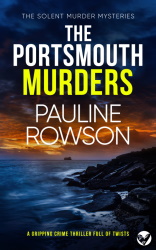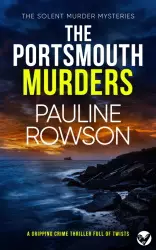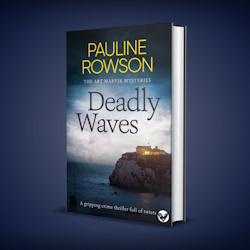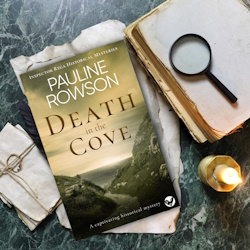
Time frames in novels, and particularly when writing a series, as with the DI Andy Horton novels, the Art Marvik mystery thrillers and my 1950s set mystery series featuring Scotland Yard detective Inspector Ryga , are a tricky thing. There is ‘real time’ and there is ‘fictional time’.
In ‘real time’ I write a DI Andy Horton Solent Murder Mystery and either an Art Marvik or Inspector Ryga mystery in a year whereas in ‘fictional time’ the novels are set over a shorter time frame.
 Andy Horton was thirty nine when I created him in THE PORTSMOUTH MURDERS in 2006, which was then published as Tide of Death. By now he should be fifty six. But I assure you he isn't. However, in ‘fictional time’ sixteen novels later, he is only forty. The novels take place over twenty months ( two years when number 17 is published in November 2023). That means for DI Andy Horton there are an awful lot of murders in Portsmouth and the Isle of Wight, making it worse than Midsomer Murder on a good day!
Andy Horton was thirty nine when I created him in THE PORTSMOUTH MURDERS in 2006, which was then published as Tide of Death. By now he should be fifty six. But I assure you he isn't. However, in ‘fictional time’ sixteen novels later, he is only forty. The novels take place over twenty months ( two years when number 17 is published in November 2023). That means for DI Andy Horton there are an awful lot of murders in Portsmouth and the Isle of Wight, making it worse than Midsomer Murder on a good day!
It's said that Agatha Christie regretted making Hercule Poirot sixty when she created him because by the time she finished writing about him he would in ‘real time’ have been about a hundred and eight! In ‘fictional time’ Poirot stayed more or less the same age. I'm not saying that will happen to DI Andy Horton, he may age yet.
Following 'fictional time' allows the author to develop the back story. In DI Andy Horton's case it allows me to chart his marital break-up, his fight to gain access to his daughter, and his search for the truth behind his mother’s disappearance when he was child.
 With Art Marvik there is his struggle to adjust to civilian life in DEADLY WAVES, and from the second in the series, DANGEROUS CARGO, there is the mystery behind the death of his marine archaeologist parents’ when he was seventeen, thought to be an accident but was it? Marvik is sent on a further undercover mission in LOST VOYAGE before he has to tackle the case of what really happened to his parents in FATAL DEPTHS (4).
With Art Marvik there is his struggle to adjust to civilian life in DEADLY WAVES, and from the second in the series, DANGEROUS CARGO, there is the mystery behind the death of his marine archaeologist parents’ when he was seventeen, thought to be an accident but was it? Marvik is sent on a further undercover mission in LOST VOYAGE before he has to tackle the case of what really happened to his parents in FATAL DEPTHS (4).
In my contemporary crime novels I try to avoid mentioning the current year if I possibly can, leaving it to the imagination of the reader.
The other problem with real time is that technology changes and so too do the names of police departments as they are merged, re-organised and cut back.
In the DI Andy Horton novels I started off talking about the Serious Organised Crime Agency which in October 2013 became the National Crime Agency. It becomes increasingly difficult to keep up with all the name changes and often by the time the novel is published some of the police departments mentioned no longer exist in that format and that name.
Technology also advances so being specific in one novel can look bang-up-to-date and yet in another written a year or two later look grossly dated. MySpace, which was once all the rage, has been overtaken by Facebook in popularity, which in turn may very well also fade into the distance just as the iPad could become but a distant memory as something else replaces it. A powerful argument I think to create a police or murder mystery crime series set in the past which is what I have done with my 1950s set Inspector Ryga mysteries. Here I am specific about the year because it is an integral part of the crime novels.
 DEATH IN THE COVE is set in 1950 England, reeling from the aftermath of war with austerity and rationing biting hard. Newly promoted to detective, Inspector Ryga from Scotland Yard, is on his first solo investigation outside of London, to solve the mystery of why a man in a pin-striped suit is found murdered in an isolated cove on the Island of Portland in Dorset. This is followed by three more in the series: DEATH IN THE HARBOUR, DEATH IN THE NETS and DEATH IN THE DUNES. I have also written number five.
DEATH IN THE COVE is set in 1950 England, reeling from the aftermath of war with austerity and rationing biting hard. Newly promoted to detective, Inspector Ryga from Scotland Yard, is on his first solo investigation outside of London, to solve the mystery of why a man in a pin-striped suit is found murdered in an isolated cove on the Island of Portland in Dorset. This is followed by three more in the series: DEATH IN THE HARBOUR, DEATH IN THE NETS and DEATH IN THE DUNES. I have also written number five.
The 1950s is a fascinating period where memories of the war are very strong, and the fear of more world conflicts haunt people. Society and policing in the 1950s was vastly different to today, no mobile phones, no dashing about in high speed cars and no computers so it was extremely interesting to research and write. Using the time frame becomes easier as it is based on historical fact, however getting that correct also poses problems and it's easy to slip into errors and assume that what we now take for granted was around back then - WRONG. Attitudes and social morals were also vastly different and the books need to be written with that in mind.
Ryga might very well age gracefully, get married, have a family and secure promotion. In the first four in the series he has teamed up with independent photographer Eva Paisley. Will their relationship blossom? Both are coming to terms with their lives after their experiences of the war, and their expectations for the future, will they blend? We'll have to wait and see.
I enjoy writing all my crime series, it is always a challenge and I hope you enjoy reading them.
Pauline Rowson lives on the South Coast of England and is the best selling author of many crime novels, published by Joffe Books. Her popular crime novels include the DI Andy Horton Solent Murder Mystery series, the Art Marvik mystery thrillers and the 1950s set Inspector Ryga mysteries. Subscribe to her newsletter for all the latest books news.